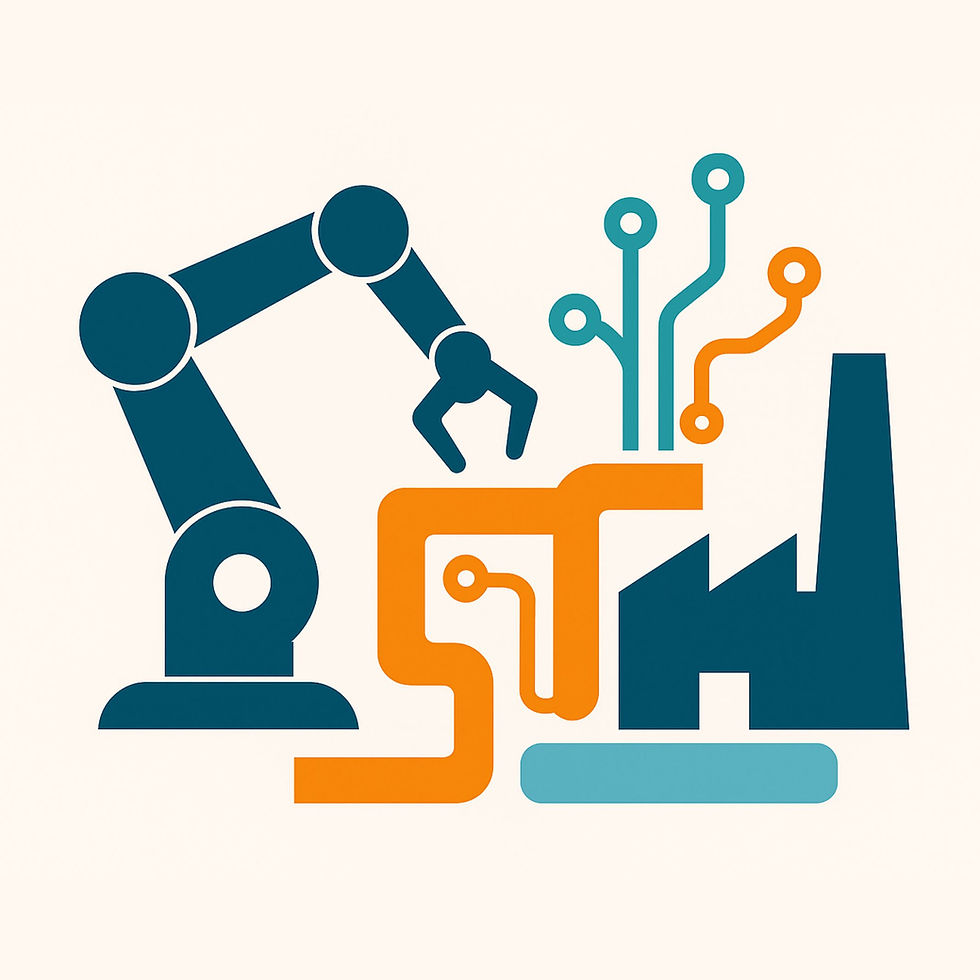AI in Manufacturing 2025: Key Trends Shaping Global Growth
- John Cheuk
- Oct 3
- 3 min read
Updated: Oct 4

As we move deeper into the digital decade, manufacturing is entering its most transformative phase since the Industrial Revolution. Across Asia and beyond, early adopters are proving that AI is no longer a support technology—it’s the new decision-making core of production ecosystems. The year 2025 marks a shift from automation to orchestration, where data, algorithms, and human expertise operate in unison to drive global competitiveness.
1. Predictive Intelligence Becomes the New Standard
Factories that once relied on static automation are now embracing predictive intelligence, where machines continuously learn from every production cycle.AI-powered models analyze sensor data from thousands of points across the shop floor, predicting micro-defects, equipment wear, and quality deviations before they occur. This is redefining OEE (Overall Equipment Effectiveness) benchmarks—where a few hours of predictive downtime prevention can translate into millions in annual savings.
At leading plants, predictive intelligence is now embedded into MES and ERP workflows, connecting the operational layer with business strategy. The result is a new level of agility: when a pattern of variance is detected in production, purchasing and planning are automatically recalibrated to mitigate risk in real time.
2. Autonomous Decision-Making Transforms Operations
In 2025, manufacturers are witnessing the rise of self-optimizing production systems. Instead of waiting for human intervention, AI-driven control algorithms autonomously adjust line speed, tool parameters, and process flows to maintain optimal efficiency.This “closed-loop optimization” marks a transition from automation to autonomy, where systems act on intelligence rather than instruction.
The competitive advantage is exponential: as each cycle generates new data, the AI learns faster, creating compounding operational intelligence that improves performance over time.Factories running such systems have reported not only higher throughput, but also sharper cost predictability—a key differentiator in volatile global markets.
3. Supply Chain Synchronization through AI
Manufacturing success no longer depends solely on in-factory efficiency—it’s now defined by end-to-end synchronization.AI is bridging silos between procurement, logistics, and production planning, creating what industry analysts call the “neural supply chain.”By continuously interpreting real-time signals from suppliers, ports, and customers, AI-driven ERP systems dynamically reconfigure schedules, production orders, and material flows.
This data-driven responsiveness has become essential in 2025’s supply environment—where a delay in one continent can ripple globally within hours.The leaders are those who have embedded AI-driven risk sensing and decision orchestration into their core systems, transforming uncertainty into actionable foresight.
4. The Human-AI Partnership: From Operators to Orchestrators
Contrary to common fears, AI is not replacing the human workforce—it’s redefining their role.Planners, engineers, and supervisors are becoming AI orchestrators, empowered by machine intelligence to make faster, more strategic decisions.AI handles data overload, pattern recognition, and scenario modeling, while humans focus on interpreting insights, guiding innovation, and setting direction.
In top-performing factories, this collaboration has led to a 50–70% reduction in planning time and a dramatic improvement in cross-departmental coordination. The human workforce is evolving from execution to intelligence supervision—a paradigm shift at the core of the next industrial era.
5. Sustainability as a Data Problem—Solved by AI
Environmental performance is now a business metric.AI-driven analytics are allowing manufacturers to measure carbon intensity, material utilization, and energy efficiency with precision never before possible.By modeling energy usage in real time, AI helps plants optimize production schedules to minimize waste and reduce emissions, aligning profitability with sustainability.
This convergence—AI for green manufacturing—is particularly strong in Asia, where rapid industrialization is being met with rising ESG expectations.Forward-looking companies are using AI not just for compliance, but as a competitive advantage to secure eco-conscious customers and investors.
6. The Great Divide: Scaling AI Beyond Pilots
The challenge for most manufacturers isn’t starting with AI—it’s scaling it.While proof-of-concept projects are common, only a fraction of companies have successfully integrated AI into enterprise-wide workflows.The key lies in systemic integration—embedding AI into ERP, MES, and quality systems, rather than treating it as a bolt-on tool.
Leaders in 2025 are building AI-native architectures, where continuous learning is part of every process loop.This creates a “flywheel effect” of compounding improvement—each production run trains the model, which in turn enhances the next cycle’s outcome.
A New Era of Manufacturing Intelligence
The factories of 2025 are not defined by how many robots they have, but by how intelligently they think.AI is now the brain that unites machines, systems, and people into one adaptive ecosystem.In this landscape, success is not determined by automation capacity, but by cognitive agility—the ability to learn, predict, and adapt faster than competitors.
Manufacturers who embrace AI as a strategic intelligence layer—not just a technology upgrade—will lead the next decade of industrial growth, shaping a future where precision, sustainability, and speed coexist by design.








Comments